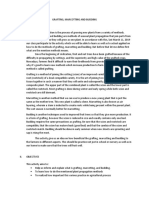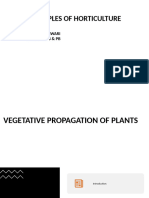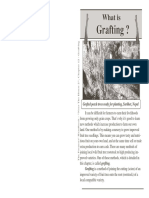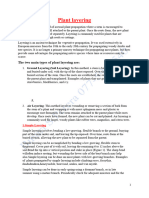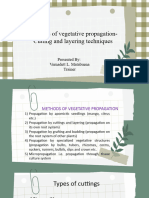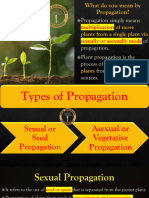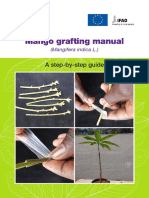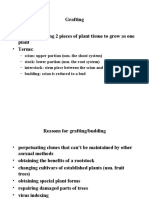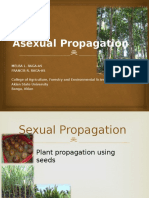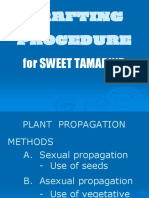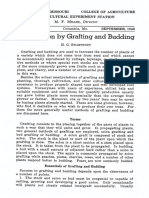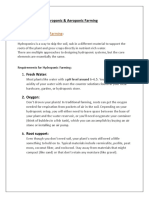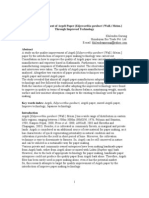0 ratings0% found this document useful (0 votes)
1 viewsPropagation Technique of Layring Grafting 1
Propagation Technique of Layring Grafting 1
Uploaded by
Joshuedwight BolitoPropagation techniques
Copyright:
© All Rights Reserved
Available Formats
Download as PDF, TXT or read online from Scribd
Propagation Technique of Layring Grafting 1
Propagation Technique of Layring Grafting 1
Uploaded by
Joshuedwight Bolito0 ratings0% found this document useful (0 votes)
1 views21 pagesPropagation techniques
Original Title
Propagation-technique-of-Layring-Grafting-1
Copyright
© © All Rights Reserved
Available Formats
PDF, TXT or read online from Scribd
Share this document
Did you find this document useful?
Is this content inappropriate?
Propagation techniques
Copyright:
© All Rights Reserved
Available Formats
Download as PDF, TXT or read online from Scribd
Download as pdf or txt
0 ratings0% found this document useful (0 votes)
1 views21 pagesPropagation Technique of Layring Grafting 1
Propagation Technique of Layring Grafting 1
Uploaded by
Joshuedwight BolitoPropagation techniques
Copyright:
© All Rights Reserved
Available Formats
Download as PDF, TXT or read online from Scribd
Download as pdf or txt
You are on page 1of 21
Lecture on
Propagation Technique of Layering & Grafting
Presented by
Dr. Somendra Verma
Department of Fruit Science
C. S. Azad University of Agriculture & Technology, Kanpur
(U. P.)- 208 002
Contents
LAYERING GRAFTING
❑ Definition ❑ Definition
❖ How root formation takes place in Rootstock & Scion
layering
Types of Grafting-
❖ Etiolation
Types of Layering- 1) Veneer grafting
2) Tongue grafting
1) Simple layering
3) Cleft grafting
2) Serpentine or compound Layering
4) Wedge grafting
3) Mound layering or stooling 5) Bridge grafting
4) Tip Layering 6) Epicotyl grafting
5) Air Layering 7) Soft wood grafting
6) Trench Layering 8) Whip grafting
Layering:- Layering is the development of roots on a
stem while it is still attached to the mother plant.
❑ The rooted stem is them detached to become a new
plant growing on its own roots.
How root formation takes place in layering:-
❑ Root formation during layering is stimulated by
various stem treatments which cause an interruption in
the downwards translocation of carbohydrate, auxin and
other growth factors from leaves and growing shoot tips.
❑These materials accumulate near the point of the
treatment and rooting occurs in this area even
though the stem is attached to the parent plant.
❑ Water and nutrients are supplied to the layered
shoots, because the xylem remains intact.
❑ This is how the root formation takes place in
simple, serpentine and air layering.
Etiolation:-
❖ That means the internal condition of the
developing shoot can be modified during layering
to stimulate rooting.
❖The absence of light is favorable for initiation
of root primordia in the stem tissues.
❖This is how root formation take place in
Mound and Trench layering.
Types of layering
1. Simple Layering-
❑Low flexible one year old shoots
which bend freely are selected.
❑Remove a ring of bark at 20-25
cm away from the growing tip
and this wounded portion is
then buried in the soil.
❑Ideal time- Early spring or rainy
season.
❑Roots are developed in 4-5
months.
E.g.- Lime, Lemon, Guava
2. Tip Layering
❑ The tip of the current
season shoot is placed
5-7 cm below the soil
for rooting.
❑Time taken for
development of roots
may be 2-3 months.
❑E.g.- Blackberries and
Raspberries.
3. Air Layering
❑ Air layering also called Chinese layering or Gootee.
❑ Previous season shoot of pencil thickness is selected.
❑ A girdle is made on the selected shoot by removing 2.5-3 cm bark.
❑ Girdle portion is then covered by using moist sphagnum moss grass and then
wrapped with transparent polythene tape.
❑ Rooting appears in 2-3 months.
❑ Ideal time :– July-August.
E.g.- Guava, Jackfruit, Litchi, Lime.
4. Serpentine Layering
✓ This method is practiced in
plants having long soft shoots
which bend easily.
✓ The shoots are covered and
exposed alternately along the
length.
✓ Adventitious roots and new
shoots are formed from the
nodes buried into the soil.
E.g.- Muscadine grape.
5. Mound Layering
❖ It is also known as Stooling.
❖ In this method the plant is headed
back to 5-7.5 cm above the ground
level during dormant season.
❖ As the season progresses, new shoots
emerge out from the base of the
plant.
❖ These shoots are girdled at the base
and it is covered with soil to height of
about 15-20 cm.
❖ After 1 year, the shoots are rooted
and removed from the parent plant.
E.g.- Guava, Apple, Pear.
6. Trench Layering
➢ This method is also known as
Etiolation method of layering
because there is complete
covering of branch under the
soil.
➢ Selected branch is bent to the
ground and buried completely
in shallow trench.
➢ Plants form at each node on
covered branch.
E.g.- Apple, Pear, Cherry.
Grafting
Definition- Grafting is an asexual method
propagation in which parts of two different plants
are joined so that they continue their growth as one
plant. (Muthukumar and Selvakumar, 2017).
Scion- The desired variety which is grafted
or budded on a stock plant and forms the
shoot system.That plant part which is placed
Interstock-
in between stock and scion to tide over the
problem of incompatibility.
Stock- The plant part which will give rise to
the root system and into which a bud or
Types of Grafting
1. Inarching:
❑ Grafting by means of uniting a growing branch to a
stock without separating the branch from its parent
stock.
❑ Both the scion and the stock should be of pencil
thickness.
❑ Ideal time- July-August.
E.g.- Mango, Jackfruit ,Sapota Loquat.
Scion
Root
stock
2. Veneer Grafting:
❑A shallow downward and inward cut of about 3-4 cm
length is made 15 cm above the ground on rootstock.
❑A long cut is made on one side of the scion.
❑Then scion is placed into the rootstock and tied with
300 gauge polythene tape.
E.g.- Mango.
❑ Ideal time- August- September
3. Cleft Grafting:
• Also called Wedge grafting.
• It is a method for top working in order
to change varieties.
• Wedge shaped incision of about 5 cm
length is prepared on the stub of the
plant.
• Similar matching incision is prepared
on lower portion of scion.
• The scion is inserted in root stock
firmly and waxed.
• E.g.- Mango, Hazelnut, Pecanut,
Apple.
4. Whip Grafting:
❖A plant graft made by cutting both
stock and scion across obliquely,
fitting the cut surfaces so that the
cambiums are in contact, and
tying.
❖Also called splice grafting.
❖In splice grafting, both the stock
and scion must be of the same
diameter.
❖It is highly successful due to
considerable cambial contact.
E.g.- Walnut, Pecanut, Hazelnut.
5. Tongue Grafting:
✓ Diagonal cuts on stock and scion showing the
position of tongue are made.
✓Complete graft is wrapped with grafting tape.
✓It is done in apple, apricot, peach and pear.
✓It is done during Feb-March.
6. Bridge Grafting:
❑ It is a form of repair grafting.
❑ This method is practiced in plants in which scion is
healthy and some portion of rootstock near collar region
is diseased or damaged.
❑ The damaged portion of the rootstock is scratched and
incision is made on top and bottom portion of healthy
portion of stock.
❑ The scion of suitable length is inserted into incision and
fixed using nail and then sealed.
7. Epicotyl Grafting:
❖Also known as Stone grafting.
❖Epicotyl portion of rootstock seedling is replaced by a
young shoot tip.
❖Conducted with 2-3 months old scion on 7-10 days old
germinated seedlings(Singh, 2015).
❖Ideal time- Rainy Season.
E.g.- Mango.
8. Soft-wood Grafting:
❖This is very successful method of in-situ
grafting.
❖The grafting is done in the permanent
site of planting in the field itself.
Scion
❖3-5 month old scion shoot are grafted on
1 year old rootstock.
❖Ideal time:- July-August.
E.g.- Mango, Cashew, Tamarind.
Stock
Thank You
You might also like
- Grafting, Marcotting, BuddingDocument9 pagesGrafting, Marcotting, BuddingJoanna ObregonNo ratings yet
- Asexual PropagationDocument22 pagesAsexual PropagationDivina Gracia Barrion Cuya100% (2)
- Solid Waste Managment in Haxara Uni HaripurDocument19 pagesSolid Waste Managment in Haxara Uni HaripurPrincess NikNo ratings yet
- E.g., Mango and Sapota Can Be Successfully Propagated in Commercial Scale Only byDocument24 pagesE.g., Mango and Sapota Can Be Successfully Propagated in Commercial Scale Only bySharmitha SaravananNo ratings yet
- Lesson 6.5Document20 pagesLesson 6.5Binuri SandarekhaNo ratings yet
- 10 To Demonstrate Different Nursery TechniqueDocument7 pages10 To Demonstrate Different Nursery TechniqueVishal MuliyaNo ratings yet
- Plant Propagation by GraftingDocument16 pagesPlant Propagation by GraftingHazel LontocNo ratings yet
- Plants PropagationDocument13 pagesPlants PropagationKristine Delos SantosNo ratings yet
- Grafting 200208122023Document20 pagesGrafting 200208122023Manilyn GaranganaoNo ratings yet
- Grafting EPPDocument11 pagesGrafting EPPLforLunterlelXD LunNo ratings yet
- Presentation PGDocument41 pagesPresentation PGSundar RagavanNo ratings yet
- 12 GraftingDocument11 pages12 GraftingadnhasNo ratings yet
- Altoire Nuc Pe Portaltoi Tanar-EngDocument4 pagesAltoire Nuc Pe Portaltoi Tanar-Engmarius1979No ratings yet
- Plant PropagationDocument36 pagesPlant PropagationDeepa ChoudharyNo ratings yet
- GraftingDocument38 pagesGraftingISHITA GUPTANo ratings yet
- Plant PropagationDocument6 pagesPlant PropagationAminalhaya UsmanNo ratings yet
- Grafting: When To GraftDocument10 pagesGrafting: When To Graftmahe_sce4702No ratings yet
- Lesson 6.4Document14 pagesLesson 6.4Binuri SandarekhaNo ratings yet
- Grafting and Budding Nursery Crop PlantsDocument10 pagesGrafting and Budding Nursery Crop PlantsElvin Nobleza PalaoNo ratings yet
- Forestry 8 Nursery Management Grafting BuddingDocument25 pagesForestry 8 Nursery Management Grafting Buddingkeith hernandezNo ratings yet
- Grafting: Grafting and Budding Nursery Crop Plants AG-396Document9 pagesGrafting: Grafting and Budding Nursery Crop Plants AG-396Marlin GooseNo ratings yet
- Vegetative PropagationDocument4 pagesVegetative Propagationdevaprabhats04No ratings yet
- Budding TechniquesDocument27 pagesBudding TechniquesGwendie Kaye Rigor-GallardeNo ratings yet
- Plant Propagation GraftingDocument5 pagesPlant Propagation GraftingHarshal DeshmukhNo ratings yet
- Plant PropagationDocument2 pagesPlant PropagationMarie Grace SuarezNo ratings yet
- Mthds OfVeg - Prop.cuttingslayering Technqs.Document40 pagesMthds OfVeg - Prop.cuttingslayering Technqs.Justin MillapreNo ratings yet
- Plant PropagationDocument27 pagesPlant Propagationrolan benNo ratings yet
- Propagation LectureDocument72 pagesPropagation LectureSrikar VarmaNo ratings yet
- Grafting HO 05 MG 21Document2 pagesGrafting HO 05 MG 21EscolopendrasNo ratings yet
- Lesson 1 - Plan PropagationDocument36 pagesLesson 1 - Plan PropagationLance Andrew S. GacayanNo ratings yet
- Marco TtingDocument4 pagesMarco TtingMark John BernaldezNo ratings yet
- Umesh Thappa Plant PropagationDocument11 pagesUmesh Thappa Plant PropagationLoma somNo ratings yet
- Budding AssignmentDocument6 pagesBudding Assignmentsuman pranhaNo ratings yet
- Propagation Methods in PlantsDocument36 pagesPropagation Methods in PlantsThea PadlanNo ratings yet
- Methods of Plant Propagation: Sexually and Asexually Propagating PlantsDocument30 pagesMethods of Plant Propagation: Sexually and Asexually Propagating PlantsCarrylle Janne NovalNo ratings yet
- Mango Grafting Manual: A Step-By-Step GuideDocument16 pagesMango Grafting Manual: A Step-By-Step GuideArie-Ana MillerNo ratings yet
- PropagationDocument9 pagesPropagationDanque Hillary NicoleNo ratings yet
- Mango Grafting - Web VersionDocument16 pagesMango Grafting - Web VersionChamadi BabaNo ratings yet
- Practical Grafting Guide PDFDocument9 pagesPractical Grafting Guide PDFtheomatheo100% (1)
- Floriunit3 2Document58 pagesFloriunit3 2Ezra Grancho AbadNo ratings yet
- Types and Techniques of BuddingDocument21 pagesTypes and Techniques of Buddinganin012583100% (1)
- Grafting: - Defn: Connecting 2 Pieces of Plant Tissue To Grow As One - TermsDocument33 pagesGrafting: - Defn: Connecting 2 Pieces of Plant Tissue To Grow As One - TermsKurt NeyloveNo ratings yet
- Asexual PropagationDocument25 pagesAsexual PropagationchacharancharanNo ratings yet
- Hello Ka Agrillenial!: Grade 11Document25 pagesHello Ka Agrillenial!: Grade 11yahgieNo ratings yet
- 4.02 Plant PropagationDocument22 pages4.02 Plant PropagationRuby Joy ClaroNo ratings yet
- Plant Propagation by Grafting and BuddingDocument41 pagesPlant Propagation by Grafting and BuddingrandylyncabatuanNo ratings yet
- Grafting Procedure: For Sweet TamarindDocument41 pagesGrafting Procedure: For Sweet TamarindHermie LicuanNo ratings yet
- Vegetative PropogationDocument4 pagesVegetative PropogationkzrdurNo ratings yet
- Ho 1Document3 pagesHo 1Llna HnNo ratings yet
- Resource000844 Rep884Document4 pagesResource000844 Rep884NVAzirNo ratings yet
- Plant PropagationDocument33 pagesPlant PropagationJake GomezNo ratings yet
- Final Tarp Cs5Document1 pageFinal Tarp Cs5Jess YsulanNo ratings yet
- Propogation by GraftingDocument11 pagesPropogation by GraftingJACOLINE DUPLESSIS100% (1)
- Introduction To Fruit Tree GraftingDocument28 pagesIntroduction To Fruit Tree Graftingjagmaharaj67% (3)
- Mango PropagationDocument12 pagesMango PropagationDr. Govind VishwakarmaNo ratings yet
- Plant Reproduction - Sexual and Asexual Worksheet For Form 5Document52 pagesPlant Reproduction - Sexual and Asexual Worksheet For Form 5api-262572717100% (7)
- Proyekto Sa EPP: Kalvin D. Cruz VI - Rizal Mr. MedilloDocument8 pagesProyekto Sa EPP: Kalvin D. Cruz VI - Rizal Mr. MedilloGrace Mendoza MalicdemNo ratings yet
- Beginners' Guide To Fruit Growing - The Elementary Practices Of Propagation, Planting, Culture, Fertilization, Pruning, Spraying, Etc.From EverandBeginners' Guide To Fruit Growing - The Elementary Practices Of Propagation, Planting, Culture, Fertilization, Pruning, Spraying, Etc.No ratings yet
- Methods of Budding for the Gardener - With Information on Grafting, Cutting and Other Aspects of BuddingFrom EverandMethods of Budding for the Gardener - With Information on Grafting, Cutting and Other Aspects of BuddingNo ratings yet
- Response of Newly Collected Acetobacter Isolates in Sweet Corn (Zea Mays L. Saccharata)Document5 pagesResponse of Newly Collected Acetobacter Isolates in Sweet Corn (Zea Mays L. Saccharata)HARI NARAYANNo ratings yet
- Abstract:: Vivek - Sharma@icar - Gov.inDocument7 pagesAbstract:: Vivek - Sharma@icar - Gov.inshalini aroraNo ratings yet
- Company Profile - Hesco 2013Document10 pagesCompany Profile - Hesco 2013Kakira Lions ClubNo ratings yet
- GR Maharashtra Tourism PolicyDocument41 pagesGR Maharashtra Tourism PolicyVijay JamdarNo ratings yet
- CHP 3A10.1007 2F978 1 4020 4585 1 - 3Document618 pagesCHP 3A10.1007 2F978 1 4020 4585 1 - 3Adhi NurcholisNo ratings yet
- Hydroponic & Aeroponic FarmingDocument7 pagesHydroponic & Aeroponic FarmingSagar DwivediNo ratings yet
- Quality Improvement of Argeli Paper (Edgeworthia Gardneri) Through Improved TechnologyDocument5 pagesQuality Improvement of Argeli Paper (Edgeworthia Gardneri) Through Improved TechnologykhilendragurungNo ratings yet
- 08 Tanzania CS SJH 2020Document29 pages08 Tanzania CS SJH 2020iGotheInfoNo ratings yet
- Black Tulip A B 2Document2 pagesBlack Tulip A B 2Nada GarelnabiNo ratings yet
- The Industrial Revolution 3 EsoDocument15 pagesThe Industrial Revolution 3 EsoAitana RlNo ratings yet
- Grocery Product ListDocument4 pagesGrocery Product ListDaizy ShahNo ratings yet
- Excavation EquipmentDocument32 pagesExcavation EquipmentAlyssa Obligado100% (1)
- Kanji Radicals CheatsheetDocument3 pagesKanji Radicals CheatsheetKoustubh ThoratNo ratings yet
- Ecological Indicators: Lorenzo Benini, Vittoria Bandini, Diego Marazza, Andrea ContinDocument11 pagesEcological Indicators: Lorenzo Benini, Vittoria Bandini, Diego Marazza, Andrea ContinPilar Fernanda AlfonsoNo ratings yet
- From Smartcity To The Food Parliament:: An Investigation Into The Urban Consequences of Food TransparencyDocument196 pagesFrom Smartcity To The Food Parliament:: An Investigation Into The Urban Consequences of Food TransparencyNguyễn Hoàng Anh TuấnNo ratings yet
- Book 2 An Introduction To KBSR / Upsr Vocabulary (Word Level)Document16 pagesBook 2 An Introduction To KBSR / Upsr Vocabulary (Word Level)Nik MahzonNo ratings yet
- Implementability of Municipal Transport Master Plan of Bandipur Inner Ring Road Tanahun NepalDocument8 pagesImplementability of Municipal Transport Master Plan of Bandipur Inner Ring Road Tanahun NepalRoman PanditNo ratings yet
- Yellow Daisies 04Document16 pagesYellow Daisies 04Dan DanutNo ratings yet
- Kagera TfcaDocument2 pagesKagera Tfcaapi-278754474No ratings yet
- XYLANASEDocument4 pagesXYLANASEAinul MahbubillahNo ratings yet
- Amazonas - May June 2013Document100 pagesAmazonas - May June 2013Acraa100% (2)
- Ringkasan Hasil-Hasil Penelitian Badan Litbang Kehutanan Tahun 2001Document204 pagesRingkasan Hasil-Hasil Penelitian Badan Litbang Kehutanan Tahun 2001Irwan DigitecNo ratings yet
- 07 - Review of LiteratureDocument27 pages07 - Review of LiteratureAllaysa Joy ComalNo ratings yet
- The Bogor Botanical GardenDocument4 pagesThe Bogor Botanical GardenthebhumyamcaNo ratings yet
- 4 Prim 1 Term Full 2024Document22 pages4 Prim 1 Term Full 2024rasha awadNo ratings yet
- A Project Report On Organizational Study of Dharwad Milk Union LimitedDocument51 pagesA Project Report On Organizational Study of Dharwad Milk Union LimitedBabasab Patil (Karrisatte)100% (2)
- Mode of Production DebateDocument9 pagesMode of Production DebateAli Talib100% (1)
- 2012-05-03 The County TimesDocument32 pages2012-05-03 The County TimesSouthern Maryland OnlineNo ratings yet
- Agrarian (Midterms)Document18 pagesAgrarian (Midterms)Nelia Mae S. VillenaNo ratings yet
